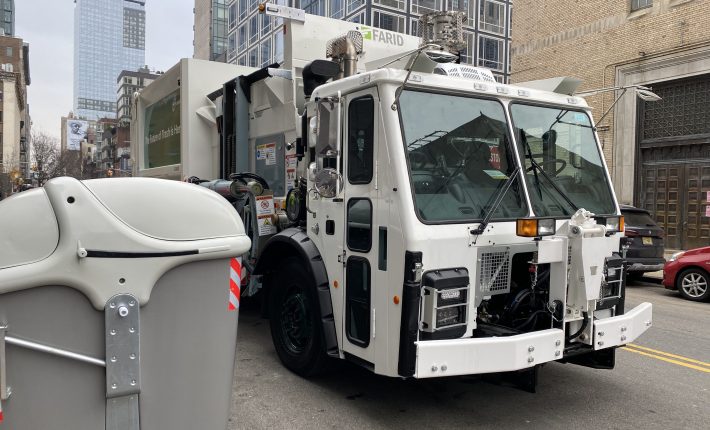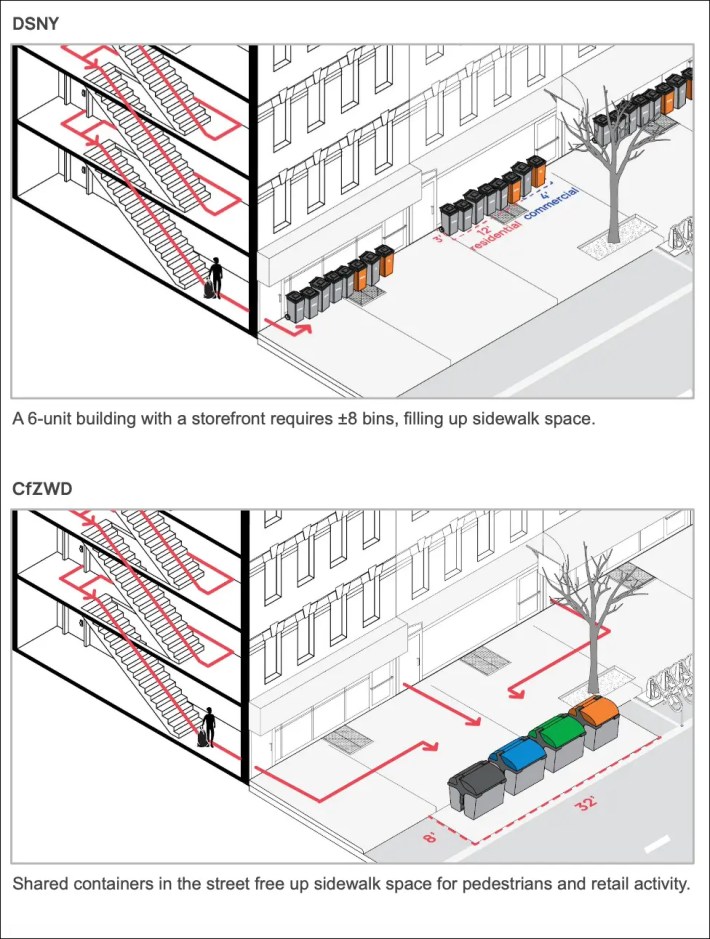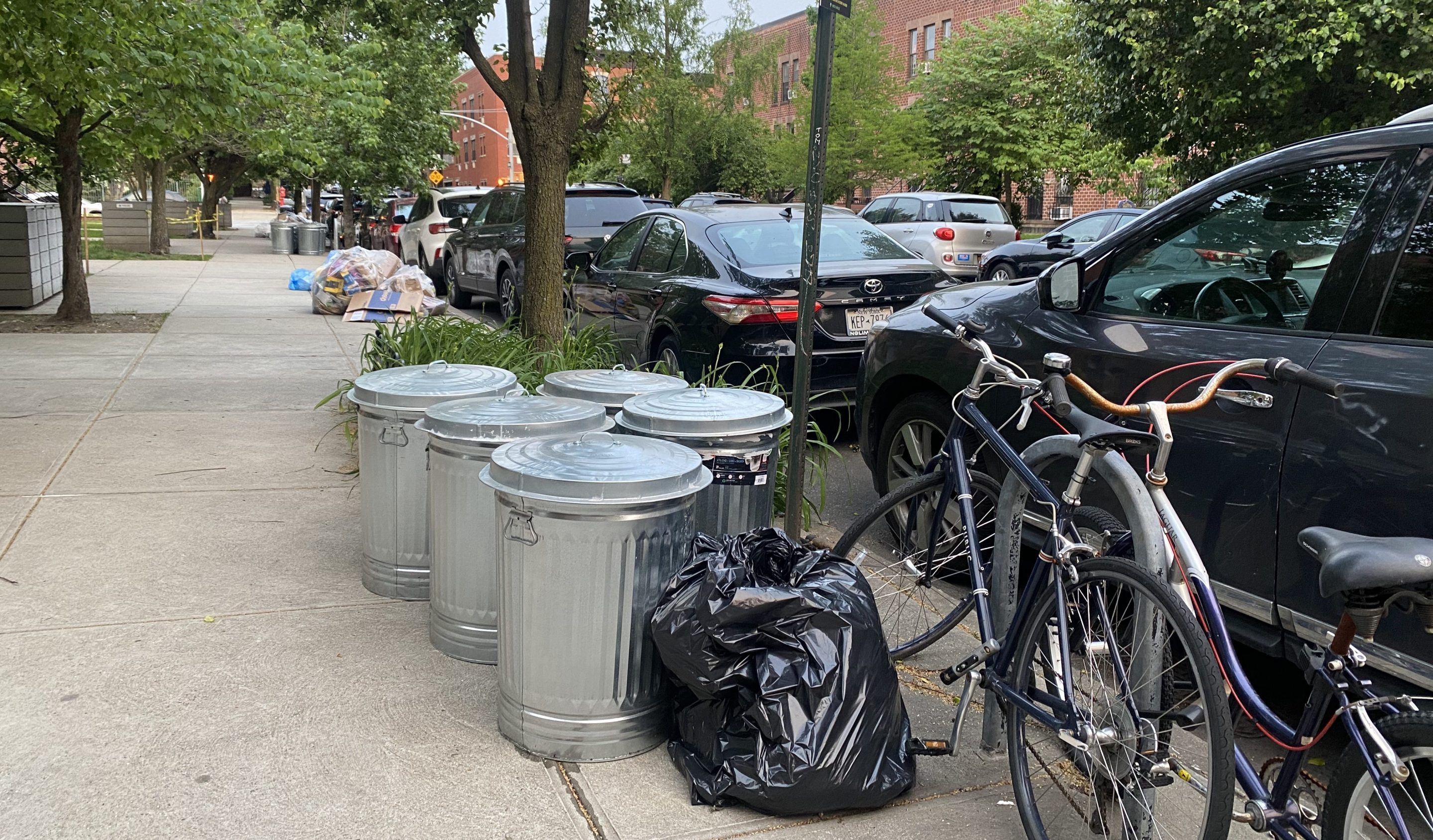It's one step for small buildings.
Starting Tuesday, New Yorkers who live in building with nine of fewer units must put their trash out in bins on the sidewalk as part of Mayor Adams's plan to curb the city's dirty habit of dumping its rubbish in piles of stinky bags.
Hizzoner announced the upcoming change over the summer when he infamously rolled out one of the city's new official wheelie bins at a Gracie Mansion press conference widely derided by international media who mocked the city for finally catching up to 19th century trash collection technology.
Still, the move is monumental for a city that first began leaving trash out in loose bags more than 50 years ago — as Department of Sanitation officials rightly noted.
"This residential containerization requirement is the first citywide containerization of residential garbage in generations," DSNY spokesman Vincent Gragnani said in a statement. "As of next Tuesday, an astonishing 70 percent of New York City trash will be in containers — something unthinkable just a few years ago."
The city has relied on the pervasive plastic bag since the administration of Mayor John Lindsay, who adopted them citywide in 1970 following a sanitation strike two years earlier that left garbage to pile up in the streets.
Oscar the Grouch-style cans were the norm before then, but the strike and a donation of 200,000 trash bags by the plastic industry prompted the city to pivot. One city official described the transition as the "most significant advance in garbage collecting since the motorized garbage truck replaced the horse and wagon," the New York Times reported at the time.
DSNY has advanced its containerization effort as part of Mayor Adams's war on rats. Officials required wheeled bins for all commercial waste as of the spring, a policy that covered about half of the city's daily rubbish. The agency has encouraged buildings to make the switch to bins by allowing supers to set out trash two hours earlier as long as it's in a container.
The city's borough-by-borough rollout of weekly curbside compost pickup covers all of the city as of last month, following a 2023 City Council law that made it mandatory for to separate organic waste into brown bins. Fines for noncompliance start in April.
Recycling can still go in bags on the street, since it is less enticing to the mayor's hated rodent, according to DSNY.
New York's Strongest are set to roll out much-anticipated containers in the curb lane for larger buildings, starting with a pilot program in West Harlem next June, with retrofitted trucks to unload the enclosures from the side.

But experts worry that the over-reliance on sidewalk wheelie bins will clog the Big Apple's already-scarce pedestrian spaces, replacing heaps of bags with arrays of plastic containers.
"While we are thrilled that this administration is tackling waste containerization, we believe it could be done so much better," said Clare Miflin, Executive Director for the Center for Zero Waste Design. "Going forward with a citywide plan to mandate bins for 1-9 units, which they know will cause more bins to be stationed permanently on sidewalks, is not wise."
The Center for Zero Waste Design released a report last month showing how the city could lean into using more curb space for trash collection — rather than filling up the foot path while leaving car storage untouched. Miflin said the business waste rules have already led to more bins, creating a 24/7 obstacle course.
"It is clear already that their commercial bin mandate has led to a proliferation of bins permanently obstructing sidewalks, chained to trees, storm drains, and light poles to prevent theft," she added. "The system could be so much better, it's a big compromise being rushed through to claim progress, rather than a well thought out plan."

The new rule for smaller residential building affects about one-fifth of the roughly 44 million pounds of waste the city produces each day, and covers 41 percent of the city's housing units, according to DSNY.
City officials aim to require street-side stationary for all buildings with 31 or more units — which make up most of the city's housing stock at 51 percent — while those in between at 10-30 units can choose either wheelie bins on the sidewalk or the fixed ones in the street.
For now, residents in the smaller buildings will have to use any rigid container with tight-fitting lids. They'll need to switch them out for official city-issued bins by June, 2026, at a cost of around $45-$53 per receptacle.
Building owners that don't containerize their trash can get away with a warning through the end of the year. But buildings that still leave out their trash in bags after Jan. 1 will receive fines starting at $50 — rising to $100 for the second offense and $200 for each violation after that.
Public space and waste experts have also called on the city to move containerized waste to curb, so as not to turn the sidewalks into "bin city." A residential block of mid-size buildings with 20 units, for example, could end up requiring around 600 trash and organics bins, according to the Center for Zero Waste Design report.
The paper instead urged the city to allow smaller buildings, such as as three-story row houses, to also use shared street-side containers, and to enable larger wheeled containers at big buildings for supers to bring in and out during collection, in order to leave the curb open for other uses.
DSNY advises residents to store them in alleyways (a rarity in the city), courtyards, or within three feet of the building to allow for pedestrian flow.
Adams has agreed that giving up a fraction of of the city's 3 million parking spaces was a "small price to pay" for better waste disposal, but it remains to be seen if the city's chief executive will stand his ground, given his penchant to back out of other reallocations of street space when pro-motorist forces complain.






